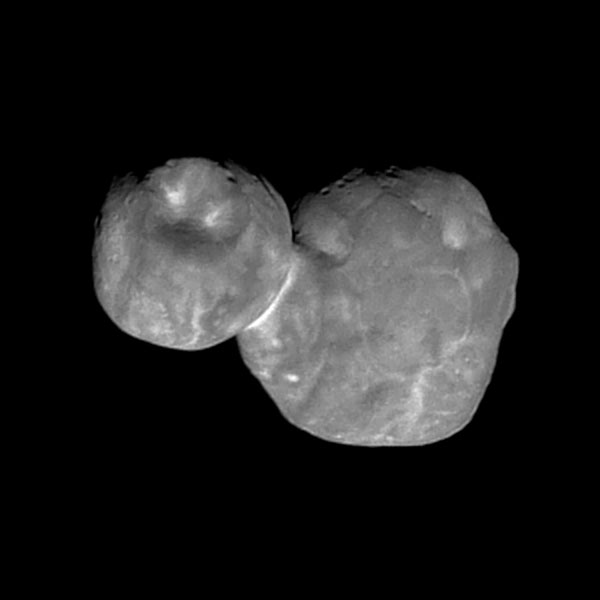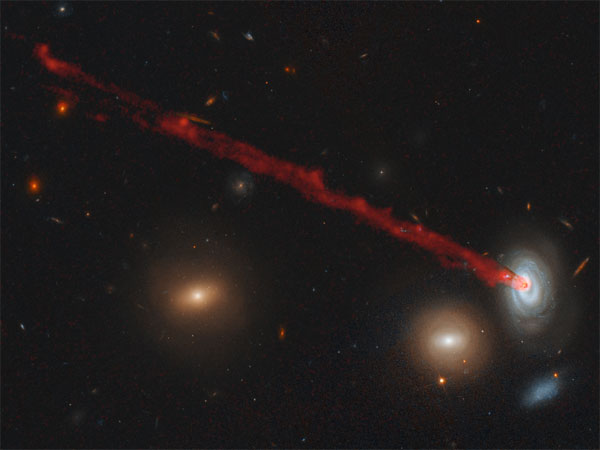This week in astronomy news, see two stunning images — one from the edge of the solar system, the newest image of Ultima Thule, and the other from the depths of the Coma Cluster of galaxies.
New Horizons' Latest Image of "Ultima Thule"
NASA's New Horizons has returned the clearest yet image of 2014 MU69, nicknamed "Ultima Thule," the Kuiper Belt object it sped by on January 1st.

NASA / JHUAPL / SWRI
The spacecraft snapped this image using the wide-angle Multicolor Visible Imaging Camera (MVIC) component of its Ralph instrument when it was just 4,200 miles (6,700 kilometers) from the icy rock, seven minutes before closest approach. While the picture was obtained on New Year's Day, it was downlinked on January 18-19th. Radio signals currently take 6 hours and 9 minutes to travel from New Horizons to Earth, and flyby data will continue trickling in through mid-2020.
The newest image has an original resolution of 440 feet (135 meters) per pixel, though the image shown above has been deconvolved, or sharpened, to enhance its finer details. The object's pitted surface is especially obvious near the terminator, the day-night boundary at the top of the image. It's not clear yet whether these pits — including the larger, 7-kilometer depression on the small lobe dubbed "Thule" — are impact craters or "collapse pits." The latter may have formed when the body vented volatile materials long ago. The image also shows intriguing light and dark markings, especially around the "neck" connecting the two bodies.
Read more in the New Horizons press release.
Hubble Images Spectacular "Tailed" Galaxy
The giant Coma Cluster, a swarm of thousands of galaxies in the Coma Berenices constellation, contains more than meets the eye: Hot gas suffuses the cluster and shapes the evolution of the galaxies within it.
Spectacular evidence for this process can be seen in this image of the spiral galaxy D100. As the galaxy plunges through the Coma Cluster, it's losing its reservoir of star-forming gas into a 200,000 light-year-long streamer, imaged through a hydrogen-alpha filter on Subaru on Maunakea, Hawai'i. A recent image from the Hubble Space Telescope caught the stars newly forming in this tail, visible as bright blue blobs near the galaxy itself.

Hubble image: NASA / ESA / M. Sun (Univ. of Alabama) / W. Cramer and J. Kenney (Yale); Subaru image: M. Yagi (NAOJ)
The galaxy's gas is stripping away due to ram pressure, which is the same pressure you feel against your face as you ride a bicycle. The faster you pump your legs, the swifter the wind against your cheeks — even if it's not a windy day. D100 feels the same pressure, though rather than cycling calmly through air, it's plunging through hot cluster gas. Eventually, this leaves the galaxy bereft of star-forming material, though stars may — and apparently do — form in the tail.
Surprisingly, even though the streamer is the length of two Milky Ways placed next to each other, it's only 7,000 light-years across. "The tail is remarkably well-defined, straight and smooth, and has clear edges," says Jeffrey Kenney (Yale University). "This is a surprise because a tail like this is not seen in most computer simulations. Most galaxies undergoing this process are more of a mess."
Part of the reason the tail is so narrow is that the galaxy has already lost gas from its outskirts and is now in the process of losing gas from its center. The team also speculates that magnetic fields permeating the stripped gas played a role in shaping the tail by inhibiting turbulence. Evidence for the presence of magnetism can be seen in the tail's filamentary — instead of clumpy — structure.
Below and to the left of the tail-trailing spiral is D99, a "red-and-dead" elliptical galaxy whose color comes from its older, redder stars. It represents a peek at D100's fate in a few hundred million years' time, after all of the star-forming gas has been stripped away.
Read more in the Hubble Space Telescope press release.
 2
2









Comments
Newbie
January 26, 2019 at 6:53 am
As a newbie on here and to astronomy, I guess my question may be laughable to you experienced members, but does Thule seem to show the coalescence of matter in the vein of planetry formation? Not a scientific person at all, just mesmerised by it all.
You must be logged in to post a comment.
Anthony Barreiro
January 28, 2019 at 6:31 pm
Yes, Ultima Thule does seem to reveal the process of planetary accretion! Alan Stern, New Horizon's principal investigator, has written a series of articles about the mission here on the S&T website and in the magazine. His most recent web article describing initial findings about Ultima Thule talks about planetary accretion.
https://skyandtelescope.org/astronomy-news/science-results-ultima-thule-flyby/
You must be logged in to post a comment.
You must be logged in to post a comment.